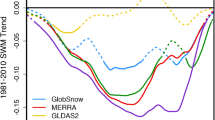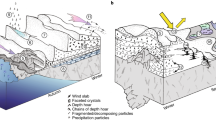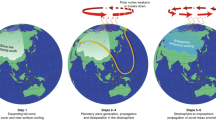Abstract
We estimate snow albedo feedback effects of anthropogenic increases in global radiative forcing, which includes carbon dioxide, methane, nitrous oxide, CFC11, CFC12, black carbon, anthropogenic sulfur emissions, total solar irradiance, and local sulfur emissions by compiling annual observations (1972–2008) for radiative forcing, temperature, snow cover, sulfur emissions, and various teleconnections for 255 \({5}^{^\circ }\times {5}^{^\circ }\) grid cells in the Northern Hemisphere. Panel DOLS estimates of the long-run relations indicate that the effect of radiative forcing on temperature increases with latitude (consistent with polar amplification), eliminating snow cover increases local temperature by about 2.8 °C, and a 1 °C temperature increase reduces snow cover by about 1%. These values create a snow albedo feedback (SAF) that amplifies the temperature increase of higher forcing by about 3.4% relative to its direct effect while an increase in sulfur emissions increases the temperature reduction by about 0.4% relative to its direct effect. The 3.4% SAF is smaller than values generated by process-based climate models and may be associated with the empirical estimates for snowmelt sensitivity \({\Delta S}_{c}/\Delta {T}_{s}\). To narrow estimates for the SAF from climate models, we conclude with suggestions for a new experimental design that controls for the simultaneous relation between temperature and snow cover.


Similar content being viewed by others
Data availability
The data and code used to estimate the results reported here will be made available through a public data repository.
Notes
Log values approximate the formulae that converts sulfur emissions to radiative forcing.
Concerns about simultaneous equation bias may be alleviated by test statistics (Pedroni 1999) that suggest variables in Eqs. (2) and (3) cointegrate. Cointegration implies that the residuals are stationary while Snow and Temp are nonstationary, which reduces any correlation between the variables and the residuals, which is the source for simultaneous equation bias.
The error correction model for Snow includes NHEM in y on the right-hand side of Eq. (7).
Although the error correction term is statistically more negative than − 1.0 (t = 4.33, p < 0.0001), the top panel in Fig. 2 indicates that temperature (and snow cover bottom panel) adjust towards equilibrium quickly.
The North Atlantic Oscillation is measured by differences in sea level pressure in December, January, and February and largely affects winter conditions.
Both cointegrating relations and the error correction models, but zeros out the effects of NAO, SOI, and Vol.
Results generated by the block bootstrap generate an SAF multiplier of 3% \(\pm 0.06\)% (standard error).
This likely overstates the size of the SAF because the TCR includes the SAF, which enhances the increase in temperature beyond the direct effect of an increase in radiative forcing.
References
Abe M, Takata K, Kawamiya M, Watanabe S (2017) Vegetation masking effect on future warming and snow albedo feedback in a boreal forest region of northern Eurasia according to MIROC-ESM. Journal of Geophysical Research: Atmospheres 122(17):9245–9261
Akaike H (1973) Information theory and an extension of the maximum likelihood principle. In: Petrov BN, Csaki F (eds) International symposium on information theory, pp 267–281
Alessandri A, Catalano F, De Felice M, vanden Hurk B, Balsamo G (2021) Varying snow and vegetation signatures of surface-albedo feedback on the Northern Hemisphere land warming. Envir Res Lett 16(3):16034023. https://doi.org/10.1088/1748-9326/abd65f
Bintanja R (2018) The impact of Arctic warming on increased rainfall. Sci Rep 8:1–6
Brodzik MJ, Armstrong R (2013) Northern hemisphere EASE-Grid 2.0 weekly snow cover and sea ice extent, version 4. Boulder, NASA National Snow and Ice Data Center Distributed Active Archive Center. https://doi.org/10.5067/P7O0HGJLYUQU. Accessed 2019
Brown RD, Robinson DA (2011) Northern Hemisphere spring snow cover variability and change over 1922–2010 including an assessment of uncertainty. Cryosphere 5:219–229
Budyko MI (1969) The effect of solar radiation variation on the climate of the Earth. Tellus 5:611–619
Cess RD, Potter GL (1988) A methodology for understanding and intercomparing atmospheric climate feedback processes in general circulation models. J Geophys Res Atmos 93(D7):8305–8314. https://doi.org/10.1029/JD093iD07p0830
Chen XS, Liang Y, Cao TH, Wang D (2015) Observed contrast changes in snow cover phenology in northern middle and high latitudes from 2001-2014. Sci Rep 5:16820. https://doi.org/10.1038/srep16820
Cox CJ, Stone RS, Douglas DC et al (2017) Drivers and environmental responses to the changing annual snow cycle of Alaska. Bull Am Meteor Soc 98:2559–2577
Denman KL, Brasseur G, Chidthaisong A, Ciais P, Cox PM, Dickinson RE, Hauglustaine D, Heinze C, Holland E, Jacob D, Lohmann U, Ramachandran s, Da Silva Dias PL, Wofsy SC, Zhang X (2007) Couplings between changes in the climate system and biogeochemistry. In: Climate change 2007: The physical science basis. Contribution of working group I to the fourth assessment report of the intergovernmental panel on climate change. Cambridge University Press.
Duan L, Cao L, Caldeira K (2019) Estimating contributions of sea ice and land snow to climate feedback. Journal of Geophysical Research: Atmospheres 124:199–208
Estrada F, Perron P, Martínez-López B (2013) Statistically derived contributions of diverse human influences to twentieth-century temperature changes. Nat Geosci 6(12):1050–1055
Fletcher CG, Thackeray CW, Burgers TM (2014) Evaluating biases in simulated snow albedo feedback in two generations of climate models. J Geophy Res: Atmos 120:12–26
Hori ME, Yasunari T (2003) NAO impact towards the springtime snow disappearance in the western Eurasian continent. Geophys Res Lett 30:1–4
Huntington TG, Hodgkins GA, Keim BD, Dudley RW (2004) Changes in the proportion of precipitation occurring as snow in New England (1949–2000). J Clim 17:2626–2636 https://journals.ametsoc.org/view/journals/clim/17/13/1520-0442_2004_017_2626_citpop_2.0.co_2.xml
Hurrell J, National Center for Atmospheric Research Staff (Eds) (2020) The climate data guide: Hurrell North Atlantic Oscillation (NAO) Index (station-based). Retrieved June 2020 from https://climatedataguide.ucar.edu/climate-data/hurrell-north-atlantic-oscillation-nao-index-station-based
Kang SM, Park K, Jin FF, Stucker MF (2017) Common warming pattern emerges irrespective of forcing location. J Adv Model Earth Syst 9:2313–2424
Kang S, Zhang Y, Qian Y, Wang H (2020) A review of black carbon in snow and ice and its impact on the cryosphere. Earth -Science Review 210:103346
Kaufmann RK, Stern DI (1997) Evidence for human influence on climate from hemispheric temperature relations. Nature 388(6637):39–44
Kaufmann RK, Stern DI (2002) Cointegration analysis of hemispheric temperature relations. J Geophys Res 107:D2. https://doi.org/10.1029/2000JD000174
Kaufmann RK, Kauppi H, Stock JH (2006a) Emission, concentrations, & temperature: a time series analysis. Climatic Change 77:249–278
Kaufmann RK, Kauppi H, Stock JH (2006b) The relationship between radiative forcing and temperature: what do statistical analyses of the instrumental temperature record measure? Climatic Change 77:279–289
Kaufmann RK, Kauppi H, Mann ML, Stock JH (2011) Reconciling anthropogenic climate change with observed temperature 1998–2008. Proc Nat Acad Sci 108(29):11790–11793. https://doi.org/10.073/pnas.1102467108
Kaufmann RK, Kauppi H, Mann ML, Stock JH (2013) Does temperature contain a stochastic trend: linking statistical results to physical mechanisms. Clim Change. https://doi.org/10.1007/s10584-012-0683-2
Kessler M, Rahbek A (2004) Identification and inference for multivariate cointegrated and ergodic Gaussian diffusions. Stat Infer Stoch Process 7:137–151
Kopec BG, Feng X, Michel FA, Posmentier ES (2016) Influence of sea ice on Arctic precipitation. Proc Natl Acad Sci 113(1):46–51
Letcher TW, Minder JR (2015) Characterization of the simulated regional snow albedo feedback using a regional climate model over complex terrain. J Clim 28(19):7576–7595. https://doi.org/10.1175/JCLI-D-15-0166.1
Lupikasza EB, Cielecka-Nowak K (2020) Changing probabilities of days with snow and rain in the Atlantic sector of the Arctic under the current warming trend. J Clim 33:2509–2514
Magnus JR, Melenberg B, Muris C (2011) Global warming and local dimming: the statistical evidence. J Am Stat Assoc 106(494):452–464
Mann ME (2011) On long range temperature dependence in global surface temperature series. Clim Change 107:267–276
Mark NC, Sul D (2013) Cointegration vector estimation by panel DOLS and long-run money demand. Oxford Bullet Econ Stat 65(5):655–680
Meehl GA, Senior CA, Eyring V et al (2020) Context for interpreting equilibrium climate sensitivity and transient climate response from the CMIP6 Earth system models. Sci Adv 6:1–10
Morice CPJJ, Kennedy NA, Rayner PDJ (2012) Quantifying uncertainties in global and regional temperature change using an ensemble of observational estimates: the HadCRUT4 data set. J Geophys Res. https://doi.org/10.1029/2011JD017187
Myhre G, Shindell D, Bréon F-M, Collins W, Fuglestvedt J, Huang J, Koch D, Lamarque J-F, Lee D, Mendoza B, Nakajima T, Robock A, Stephens G, Takemura T, Zhang H (2013) Anthropogenic and natural radiative forcing supplementary material. In: Stocker TF, Qin D, Plattner G- K, Tignor M, Allen SK, Boschung J, Nauels A, Xia Y, Bex V, Midgley PM (eds) Climate change 2013: The physical science basis. Contribution of working group I to the fifth assessment report of the intergovernmental panel on climate change. Available from www.climatechange2013.org and www.ipcc.ch
Najafi MR, Zwiers FW, Gillett NP (2016) Attribution of the spring snow cover extent decline in the Northern Hemisphere, Eurasia, and North America to anthropogenic influence. Clim Change 136:571–586
North GR (1975) Theory of energy-balance climate models. Journal of Atmospheric Sciences 32(11):2033–2043
EDGAR (2011) Olivier JG, Bouwman AF, Berdowski JJM, Veldt C, Bloos JPJ, Visschedijk AJH, Haverlag JL (1996) Description of EDGAR Version 2.0: A set of global emission inventories of greenhouse gases and ozone-depleting substances for all anthropogenic and most natural sources on a per country basis and on 1 degree x 1 degree grid. Downloaded as version 4.2. Available at: http://edgar.jrc.ec.europa.eu/overview.php?v=42
Overland J, Francis JA, Hall R, Hanna E, Kim SJ, Vihma T (2015) The melting Arctic and midlatitude weather patterns: are they connected? J Clim 28:7917–7932
Pedroni P (1999) Critical values for cointegration tests in heterogeneous panels with multiple regressors. Oxford Bull Econ Stat 61:653–670
Phillips PCB (2020) Dynamic Panel Modeling of Climate Change. Econometrics 8:30. https://doi.org/10.3390/econometrics8030030
Phillips PC, Leirvik T, Storelvmo T (2020) Econometric estimates of Earth’s transient climate sensitivity. J Econ 214(1):6–32
Pithan F, Mauritsen T (2014) Arctic amplification dominated by temperature feedbacks in contemporary climate models. Nat Geosci. https://doi.org/10.1038/NGEO2071
Pretis F (2020) Econometric modelling of climate systems: the equivalence of energy balance models and cointegrated vector autoregressions. J Econ 214(1):256–273
Previdi M, Janoski TP, Chiodo G, Smith KL, Polvani LM (2020) Artic amplification: a rapid response to radiative forcing. Geophysical Research Letter 47:e2020GL089933
Qu X, Hall A (2007) What controls the strength of snow-albedo feedback? J Clim 20:3971–3981
Qu X, Hall A (2014) On the persistent spread in snow-albedo feedback. Clim Dyn 42(L03502). https://doi.org/10.1007/s00382-013-1774-0
Raisanen J (2008) Warmer climate, less or more snow? Clim Dyn 20(2):307–319
Roe G (2009) Feedbacks, timescales, and seeing red. Ann Rev Earth Planet Sci 37:93–115
Scherrer SC, Appenzeller C, Laternser M (2004) Trends in Swiss Alpine snow days: The role of local- and largescale climate variability. Geophys Res Lett 31:L13215. https://doi.org/10.1029/2004GL020255
Scherrer SC, Ceppi P, Croci-Maspoli M, Appenzeller C (2012) Snow-albedo feedback and Swiss spring temperature trends. Theoret Appl Climatol 110:509–516
Schwarz G (1978) Estimating the dimension of a model. Annal Stat 6:461–464
Sellers W (1969) A climate model based on the energy balance of the earth-atmosphere system. J Appl Meteorol 8:392–400
Skiles SM, Flanner M, Cook JM, Dumont M, Painter TH (2018) Radiative forcing by light absorbing particles in snow. Nat Clim Chang 8:964–971
Stern DI, Kaufmann RK (2014) Anthropogenic and natural causes of climate change. Clim Change 122:257–269
Stone R, Douglas DC, Belchansky GI, Drobot S (2005) Correlated declines in pacific arctic snow and sea ice cover. National Science Foundation, USGS Publications WarehouseUR http://pubs.er.usgs.gov/publication/70176074
Storelvmo T, Leirvik T, Lohmann U, Phillips PC, Wild M (2016) Disentangling greenhouse warming and aerosol cooling to reveal Earth’s climate sensitivity. Nat Geosci 9(4):286–289
Stuecker MFCM, Bitz KC, Armour C, Proistosescu SM, Kang SP, Xie D, Kim S, MacGregor W, Zhang S, Zhao WC, a Y. Dong, and F.F. Jin, (2018) Polar amplification dominated by local forcing and feedbacks. Nat Clim Chang 8:1076–1081
Taylor PCM, Cai A, Hu J, Meehl WW, Zhang GJ (2013) A decomposition of feedback contributions to polar warming amplification. J Clim 26(18):7023–7043
Thackeray CW, Qu X, Hall A (2018) Why do models produce spread in snow albedo feedback? Geophys Res Lett 45:6223–6231
Thackeray CW, Hall A, Zelinka MD, Fletcher CG (2021) Assessing prior emergent constraints on surface albedo feedback in CMIP6. J Clim 34(10):3889–3905
Thiebault K, Young S (2020) Snow cover change and its relationship with land surface temperature and vegetation in northeastern North America from 2000–2017. Int J Remote Sens 21:8453–8474
Trenberth KE, Hoar TJ (1996) The 1990–1995 El Niño-southern oscillation event: longest on record. Geophys Res Lett. https://doi.org/10.1029/95GL03602
Vaughan DG, Comiso JC, Allison I, Carrasco J, Kaser G, Kwok R, Mote P, Murray T, Paul F, Ren J (2013) Observations: cryosphere. Climate change: the physical science basis. In: Stocker TF, Qin D, Plattner G-K, Tignor M, Allen SK, Boschung J, Nauels A, Xia Y, Bex V, Midgley PM (eds) Contribution of working group i to the fifth assessment report of the intergovernmental panel on climate change. Cambridge University Press, Cambridge
Vavrus S (2007) The role of terrestrial snow cover in the climate system. Clim Dyn 29:73–88
Winter KJPM, Kotlarski S, Scherrer SC, Schär C (2017) The alpine snow-albedo feedback in regional climate models. Climate Dynamics 48:1109–1124
Zhang R, Wang H, Fu Q et al (2019) Unraveling driving forces explaining significant reduction in satellite-inferred Arctic surface albedo since the 1980s. Proc Natl Acad Sci 116:23947–23953
Zhang X, Li X, Chen D, Cui H, Ge Q (2019) Overestimated climate warming and climate variability due to spatially homogeneous CO2 in climate modelling over the Northern Hemisphere since the mid-19th century. Sci Rep 9:17426
Acknowledgements
We thank Chen Xi for compiling the data on snow cover and Glenn Rudebusch for his suggestions regarding solar insolation. We also thank Francis X. Diebold and the attendees of the climate econometrics seminar at the University of Pennsylvania for their comments. Any errors that remain are solely our responsibility.
Author information
Authors and Affiliations
Corresponding author
Additional information
Publisher's note
Springer Nature remains neutral with regard to jurisdictional claims in published maps and institutional affiliations.
Significance statement
We analyze the relation among real-world measurements of temperature, snow, radiative forcing, sulfur emissions, and teleconnections to test ideas about anthropogenic climate change and the degree to which melting snow raises temperature beyond the initial increase in temperature. Results indicate that human emissions increase temperature, with the greatest rise at high latitudes and that eliminating snow cover would raise temperature by about 0.7 °C. Melting snow raises temperature by an additional 3%, which is smaller than the 40% indicated by climate models. This difference is likely caused by the uncertainty about the effect of higher temperatures on snow cover. To resolve this difference, we suggest experiments to be run by climate models.
Supplementary Information
Below is the link to the electronic supplementary material.
Rights and permissions
Springer Nature or its licensor (e.g. a society or other partner) holds exclusive rights to this article under a publishing agreement with the author(s) or other rightsholder(s); author self-archiving of the accepted manuscript version of this article is solely governed by the terms of such publishing agreement and applicable law.
About this article
Cite this article
Kaufmann, R.K., Pretis, F. An empirical estimate for the snow albedo feedback effect. Climatic Change 176, 107 (2023). https://doi.org/10.1007/s10584-023-03572-7
Received:
Accepted:
Published:
DOI: https://doi.org/10.1007/s10584-023-03572-7




